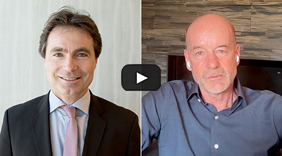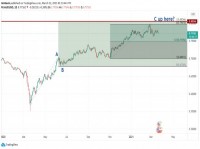|
Is Diversity in Danger? More money is coming into futures trading-see the next section, Index Tracker, for data on commodity futures growth related to index investing. We wanted to go beyond conventional wisdom and get an analytical view on how the industry is evolving as it grows. Our commentator, Michael "Mack" Frankfurter, has a distinct view on the subject. He is the co-founder and managing director of Cervino Capital Management LLC, a commodity trading advisor and registered investment adviser, and the author of numerous scholarly articles on futures markets. He was previously featured in Opalesque Futures Intelligence issue 5, April 7, 2009, where he argued about roll yield. Mr. Frankfurter has been involved in managed futures since 1991, when he joined The Echelon Group, an investment company that allocated to emerging traders and helped incubate CTAs, including Dreiss Research, Jackson Grain, Range Wise and others. The reading list at the end of this interview includes the studies and arguments he refers to. Frankfurter "What investors should be asking themselves when they allocate to large $1 billion-plus CTAs is whether or not they are just joining the herd." Opalesque Futures Intelligence: How do capital inflows affect managed futures? Mack Frankfurter: It seems that increasingly managed futures is dominated by just a few commodity trading advisors and commodity pool operators. Investors tend to gravitate towards these programs and ignore the rest-so most of the money is actually migrating into a small universe of $1 billion-plus funds. That raises the question of what kind of impact these few CTAs/CPOs have on the market when they build or liquidate a position. OFI: What does that mean for markets? MF: I, as well as others, suspect that cash flows in and out of contracts have a strong influence on commodity market direction. In that sense, one could argue that large CTAs/ CPOs have "become the market". I would add into that equation commodity exchange traded funds and notes and mutual funds such as the PIMCO Commodity Real Return Strategy Fund. Even though these investment products may be excluded from the definition, they are effectively securitized managed futures funds, for the most part trading na¯ve strategies. OFI: What does it mean for investors? MF: Managed futures is suffering from a decline in market diversity. While industry participants like to celebrate the rise of managed futures and point to its growth in assets, the facts tell a different story. Here are some numbers: of the 523 programs listed in the IASG database, 15% represent 91% of total assets. Of these, just ten programs represent 60% of the assets. I believe you would see a similar concentration in other databases tracking managed futures. OFI: There are new CTAs starting up all the time. Doesn't that enhance diversity? MF: While the barriers of entry are low for starting up a CTA, only a handful make it into the sweet spot between $10 million to $100 million in assets under management, and most do not survive past two years. From what I understand, the total number of CTAs who are actively trading is but a few hundred out of the several thousand registered CTAs. There are more CPOs, but most of these funds just allocate to a handful of the same CTAs, further diminishing market diversity. This raises the specter that the managed futures industry may be double-counting total assets under management. OFI: How do you explain the growing attraction of managed futures compared to certain other hedge fund strategies, as shown by capital inflows? MF: Managed futures is the little kid brother to the hedge fund juggernaut. Even so, its impact upon the industry is writ large in two significant and related ways. First, CTAs and CPOs, unlike their brethren hedge fund managers, have operated in a highly regulated environment for decades. After the experience of the 2008 crisis, Madoff and assorted scandals, it is no surprise that investors are more interested in liquid and regulated investments like managed futures. Second, the regulated environment of the futures industry was structured in such a way that it helped lower barriers of entry for talent. Some of that talent matured over the years and created institutions. A constant influx of new talent is healthy for the industry, but it's a tough game. Skilled CTAs may be unlucky and not raise enough assets to survive while unskilled but lucky CTAs find it easier to attract assets-until they blow up. OFI: Is managed futures a promising asset class? MF: It is not an asset class. If managed futures were confined to just commodities, maybe it could be considered representative of the commodity asset class. But with CTAs also trading financials, managed futures is as much an asset class as are registered investment advisers, mutual funds or hedge funds. OFI: But many people do consider hedge funds an asset class. So why not CTAs? MF: The underlying problem is that people mix up structure versus strategy. If mutual funds or investment advisers are not an asset class, why should hedge funds be regarded as one? Hedge funds are not an asset class and neither are CTAs or CPOs. What started out as an investment activity defined by regulation is now conventionally considered by many an asset class. OFI: If managed futures is not an asset class, what is it? MF: As with much of the lingo that the financial industry regularly comes up with, mainly for marketing reasons, the term has become a misnomer. Let's take a step back and look at what managed futures is truly representative of-professionally managed derivatives speculation. If one studies the role of the derivatives speculator as an economic agent within the economy, I suppose you could label it the "anti-asset class." I'm sure this will sound bizarre to many and will definitely not be appreciated by marketers, but if you understand the role of speculators versus hedgers within the derivatives market, that label makes as much sense as any. OFI: Okay, but how does that explain why CTAs make above market returns? MF: The futures and derivatives markets provide an important function within the economy, specifically price discovery, liquidity and reduced volatility. Such attributes benefit businesses that use the futures market to hedge and through that mechanism the economy as a whole, not necessarily speculators. If you are in the camp that thinks futures speculation is a zero-sum game – surprisingly there are those who argue this isn't the case – you reach the conclusion that the source of return comes from either a transference of so-called risk premia from risk adverse hedgers, or alternatively from an asymmetric advantage or "edge" as the old school called it, what many now refer to as "alpha". OFI: How come some CTAs make above-market returns for decades? MF: The likely source of return is behavioral-they're taking advantage of opportunities offered by irrational behavior and market disequilibria. A good example of this happened in 2008 when "dumb money" entered the market vis- -vis long-only commodity investment products. So-called "investulators" didn't understand that it is not healthy for commodity markets to be perpetually bullish. That said, it is not appropriate for CTAs to make a claim of positive alpha simply because the return is more than the risk-free rate. Managed futures is not risk free. However, certain speculators can have an edge. The adept capture risk premia from the wisdom and/or madness of crowds, which is just a fancy way of saying trend following and counter-trend speculation. OFI: You can argue that a long/short equity hedge fund belongs in an investor's equity portfolio, just like an equity mutual fund. But CTAs and global macro can't be categorized like that because they may trade almost any market via futures. How should investors classify CTAs? MF: Categorization is an understandable crutch, but it's a slippery slope that leads to pigeonholing and stifles the inquiry necessary to make investing successful. Earlier I alluded to the fact that traders can be skilled or unskilled, lucky or unlucky. I suppose one could start by dividing the investment universe into passive asset exposure versus active trading strategies. The source of return from these categories is distinct, but it raises a sticky question with respect to commodities-is passive long-only commodity exposure truly representative of the "beta" of that asset class? As to active trading strategies, the "alpha" side of this equation, one could divide that universe into a whole slew of strategies: value-motivated traders, market-makers, scalpers, day traders, position traders, momentum traders, contrarians, pure arbitrageurs, hedgers, indexers, gamblers, etc. OFI: If it's not an asset class, how can managed futures be benchmarked? MF: Well, there are studies related to this question, but there is no perfect solution. In a 2006 paper titled "The Beta of Managed Futures" Lee, Malek, Nash and Rose argue that trend following is the predominant strategy in this space. Therefore the appropriate benchmark for managed futures is one that mechanically mimics trend-following systems. That's an interesting approach and one that addresses issues related to peer group analysis and comparison. The weak part of their thesis, however, is the assumption that managed futures essentially represents trend-following strategies. OFI: Is there a way around that? MF: The paper's authors readily admit that CTAs employ a wide range of methods, and attempt to resolve that issue by creating a "beta benchmark" of twenty systems trading the most liquid markets globally. Their study found that this benchmark, for the period analyzed, was highly correlated to large CTAs. That brings us back to my initial point that a small number of $1 billion-plus CTAs/CPOs dominate the industry to such an extent that market diversity is endangered, leading to imbalances in the ecosystem such as excessive speculation. OFI: Why does this matter to investors? This line of reasoning implies that the relationship between alpha and beta is transient in nature. Think of it this way: 'beta' is akin to market herding behavior, while 'alpha' applies to speculators who obtain their source of return from culling the herd through some asymmetric advantage or edge. In other words, 'alpha' is predatory behavior, yet serves an important function by enforcing a core assumption within modern finance called "rational expectations equilibrium". What investors should be asking themselves when they allocate to large $1 billion-plus CTAs is whether or not they are just joining the herd. My view is that these large CTAs leave a big footprint and can easily be preyed upon. That's why you often see performance decline as assets under management increase. The heart and soul of managed futures, on the other hand, is more about allocating to adaptive, nimble traders not encumbered with too much capital. "Skilled CTAs may be unlucky and not raise enough assets to survive while unskilled but lucky CTAs find it easier to attract assets-until they blow up." Suggested Reading List Many of these papers can be accessed at: http://www.scribd.com/cervino_academy Lee, Timothy C.; Malek, Marc H.; Nash, Jeffrey T.; and Rosel, Jeffrey M. "The Beta of Managed Futures" (February 2006). Harris, Lawrence. "The Winners and Losers of the Zero-Sum Game: The Origins of Trading Profits, Price Efficiency and Market Liquidity" School of Business Administration, University of Southern California, Draft 0.911 (May 7, 1993). Schneeweis, Thomas. "Alpha, Alpha, Whose got the Alpha?" University of Massachusetts, School of Management (October 5, 1999). Spurgin, Richard. "Some Thoughts on the Source of Return to Managed Futures" Clark University and CISDM, Draft Article. Frankfurter, Michael Mack and Accomazzo, Davide, "Term Structure and Roll Yield: Not Your Father's Backwardation" (June 1, 2010). Available at SSRN: http://ssrn.com/abstract=1609776 Ritter, Elizabeth L. "The Securitization of Commodities: Crossing a Gold (or Silver) Line in the Sand" Business Law Brief, Fall 2005. Diz, Fernando. "How Do CTAs' Return Distribution Characteristics Affect their Likelihood of Survival?" The Journal of Alternative Investments, Vol. 2, No. 2, Fall 1999. Lo, Andrew W. and Mueller, Mark T. (2010). "WARNING: Physics Envy May Be Hazardous To Your Wealth!" MIT Sloan School of Management, Cambridge (March 19, 2010). Kaldor, Nicholas (1972). "The Irrelevance of Equilibrium Economics" The Economic Journal, Vol. 82, No. 328, pp 1237-1255 (Dec., 1972) |
|
This article was published in Opalesque Futures Intelligence.
|





 RSS
RSS












